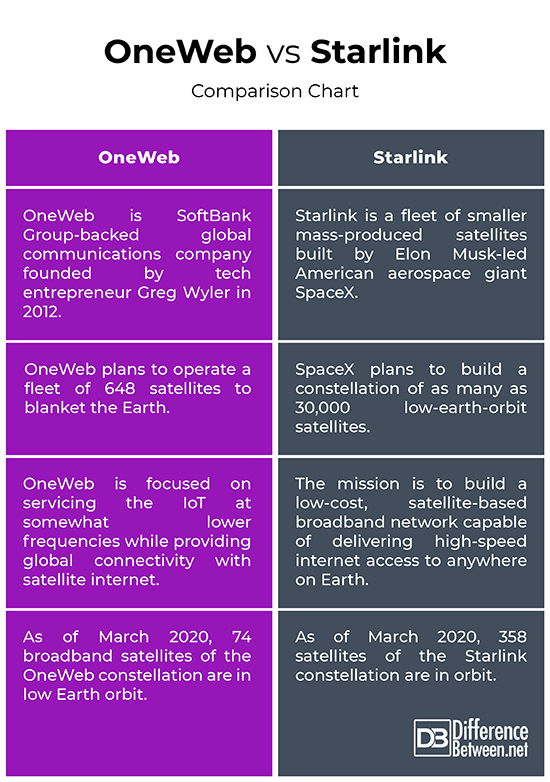Difference Between OneWeb and Starlink
The race is on to provide global connectivity with high speed internet to the Earth’s remote areas as we are entering a new era of technological dominance. It’s a space race of the 21st century with technology giants like SpaceX, Amazon, Google, Facebook, and SoftBank competing to head the race. Connectivity is the basic building block for any kind of digital services, and beyond this, connectivity can now be considered a social right. So, no wonder the competition to space Internet dominance is so stiff, especially with companies spending tens of billions of dollars to stay in the game.
Elon Musk-led SpaceX seems to be heading the race to provide satellite Internet access to millions of people living in the remote places. But, giving a tough completion to SpaceX is Japan’s SoftBank-backed satellite startup OneWeb which launched over 70 satellites into orbit in the past few months. Both the companies are launching their own smaller satellite constellations with each of them dedicated to irradiating the Earth at similar frequencies using the same phased array technology. But the industry is still in its initial stage and a couple of years away from widespread commercial adoption.

What is a Starlink?
Starlink is a smaller constellation of satellites constructed by Elon Musk-led SpaceX to provide high-speed internet access to anywhere on Earth. The constellation will consist of thousands of small satellites that will be put into low-earth orbit that will eventually allow anyone in the world to connect to the network using a low-cost ground receiver. The project was envisaged in 2018 with an objective to deploy 12,000 satellites with a possible extension to 42,000 in the later stage. In October 2019, SpaceX submitted a proposal for an additional 30,000 satellites to be deployed at some point in the future. Starlink’s mission is to build a low-cost, satellite-based broadband network capable of delivering high-speed internet access to the billions of people all across the globe. In addition, Starlink will keep the operation and maintenance costs to the minimum as they are building and launching the satellites internally. But the SpaceX satellite constellations are not the only ones.

What is a OneWeb?
OneWeb, the global communications company, in collaboration with Japan’s SoftBank Group, Qualcum, Airbus Defence and Space, and others is planning to launch their own constellation of 648 satellites, rising to perhaps 2,000 by the mid-2020s, with a mission to bring global connectivity to everyone everywhere. The company had launched 74 of the planned 648 satellites in its initial phase by March 2020. OneWeb plans to play a major role in realizing the world of IoT where all things mobile will be connected via the Internet. The goal is to provide high-speed internet access to anywhere on earth which will eventually be contributing to the bigger picture. With the initial investment of US$1 billion, SoftBank entered into an agreement with OneWeb in December 2016. In March 2020, OneWeb laid off most of its employees following a cash-crunch because of the global coronavirus pandemic and is seeking bankruptcy court protection to fund the ongoing operations.
Difference between OneWeb and Starlink
Company Profile
– Starlink is a fleet of constellation of smaller mass-produced satellites built by SpaceX, the American aerospace giant led by visionary Elon Musk. The project was envisaged in 2018 with an objective to deploy 12,000 satellites with a possible extension to 42,000 in the later stage. SpaceX plans to build a constellation of as many as 30,000 low-earth-orbit satellites. As of March 2020, 358 Starlink satellites are in orbit.
OneWeb is a global communications company that in collaboration with Japan’s SoftBak Group, Qualcum, Airbus Defence and Space, and others, plans to operate a fleet of 648 satellites to blanket the Earth. As of March 2020, OneWeb had launched a total of 74 of the planned 648 satellites, including a recent batch of 34 satellites.
Mission Objective
– While both the satellite constellations basically serve the same purpose of providing satellite Internet access to millions of people living in the remote places, the SoftBank-backed.
OneWeb is focused on servicing the IoT at somewhat lower frequencies. OneWeb plans to play a major role in realizing the world of IoT where all things mobile will be connected via the Internet.
Starlink’s mission is to build a low-cost, satellite-based broadband network capable of delivering high-speed internet access to the billions of people across the globe.
OneWeb vs. Starlink: Comparison Chart

Summary
Both OneWeb and Starlink seek to deliver global connectivity through a global satellite constellation connecting everyone, everywhere. This will bring the total number of projected new broadband satellites to around 20,000, or the number could go as high as 50,000 with the additional SpaceX satellites, with each satellite constellation dedicated to irradiating the Earth at similar frequencies using the same phased array technology. Starlink’s operational costs would be minimal considering they are building the satellites internally. The competition is stiff between the two, but SpaceX seems to be leading the race with almost 360 of their satellites in low earth orbit, while OneWeb has only 74 of the planned 648 satellites orbiting the earth.
- Difference Between Caucus and Primary - June 18, 2024
- Difference Between PPO and POS - May 30, 2024
- Difference Between RFID and NFC - May 28, 2024
Search DifferenceBetween.net :
Leave a Response
References :
[0]Mitsuru, Kodamu. Developing Holistic Strategic Management in the Advanced ICT Era. London, United Kingdom: World Scientific Europe, 2019. Print
[1]Mitsuru, Kodamu. Developing Holistic Strategic Management in the Advanced ICT Era. London, United Kingdom: World Scientific Europe, 2019. Print
[2]Brown, Steve. The Innovation Ultimatum. Hoboken, New Jersey: John Wiley & Sons, 2020. Print
[3]Kuratko, Donald F. and Sherry Hoskinson. The Challenges of Corporate Entrepreneurship in the Disruptive Age. Bingley, United Kingdom: Emerald Group Publishing, 2018. Print
[4]Naydler, Jeremy. The Struggle for a Human Future: 5G, Augmented Reality and the Internet of Things. East Sussex, United Kingdom: Temple Lodge Publishing, 2020. Print
[5]Froehlich, Annette. Legal Aspects Around Satellite Constellations. Berlin, Germany: Springer, 2019. Print
[6]Image credit: https://commons.wikimedia.org/wiki/File:Starlink_Logo.svg
[7]Image credit: https://commons.wikimedia.org/wiki/File:OneWeb_Logo.png
